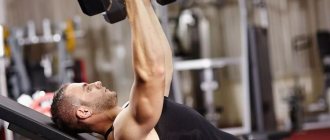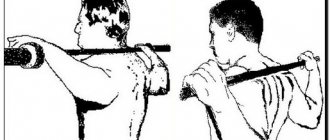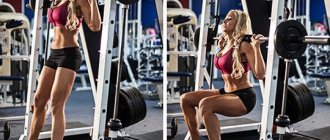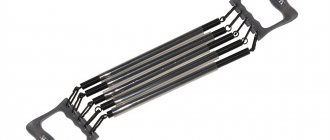Full body stretching exercises
By adding these five stretches to the end of your workout, you'll instantly feel more relaxed, mobile, and flexible. Just make sure your muscles are warmed up before passive stretching. A short, dynamic warm-up will suffice.
Each stretch should be held for 30-45 seconds once or twice. Do not stretch until it hurts or perform springy movements. Perform this set of stretching exercises 2-3 times a week. And don't forget to breathe!
Lunges with quadriceps stretch
If you exercise a lot, or sit for long periods of time during the day, then you are almost guaranteed to have tight thigh muscles. This two-in-one stretch will help target both your hip flexors and quadriceps.
Take the starting position: the front leg is bent at a right angle, and the second leg is extended back. Tighten your core and glutes, then slowly lean back and, using your hand to grab your ankle, pull your leg toward your hip as far as you can. In the final position, for the best effect, try to relax. Don't forget to work both sides.
Pigeon stretch
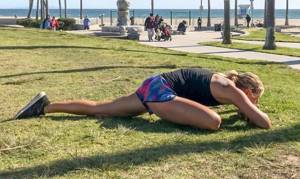
Coming from yoga, this stretch is great for targeting the glutes. It will be a great help no matter your current flexibility level or training goals.
Place one knee in front of you, leaving the other leg extended behind you. Place both hands on the floor in front of you and slowly lower your body as far as you can, keeping your hips and shoulders straight. Here your goal is to lower yourself to your elbows. If you are not yet flexible enough, stay on your palms.
Bridge on the platform
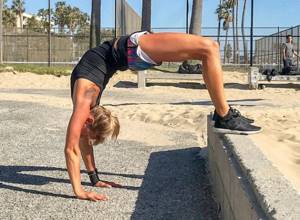
While most people are familiar with the bridge (called wheel pose in yoga) with the hands and feet on the floor, this variation with the feet elevated really allows for greater impact on the shoulders and upper back while specifically stretching the chest. Since most of us have fairly locked shoulder joints, elevated leg bridges are an amazing way to loosen and stretch the upper body without putting undue stress on the lower back.
Lie on your back with your feet on a step platform, plyo box, or other firm, elevated surface. The higher it is, the more the shoulders will stretch, but at the same time, it will be more difficult to get into the bridge. Place your hands on the floor, placing them wider than your shoulders, with your toes pointing towards your feet. Stand on your hands, lifting your hips and squeezing your glutes. Maintain even breathing, smoothly stretching the shoulder joint while keeping your gaze on your fingers.
Jackknife exercise

If you do a lot of plyometric exercises or intense leg workouts, give your hamstrings some TLC. These two variations of the classic "jackknife" will get the job done.
Sit down with your legs extended in front of you. Tighten your quadriceps, pull your stomach in, and lean forward as far as you can. Try gripping the soles of your feet for a deeper stretch.
For more advanced stretches, you can use a wall to take your hip stretch to a whole new level. But first, a warning: if you have a tight hamstring (like most people), it will hurt at first. But it's worth it!
Stand facing a wall with your feet together. Then lean forward, crossing your arms above your head, and rest your upper back against the wall. Slowly slide down the wall while keeping your legs straight. The closer you are to the wall, the deeper the stretch.
Exercise Iron Cross for chest and back stretching
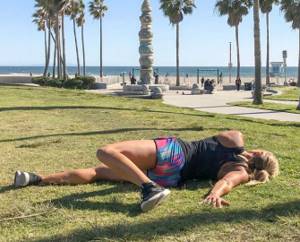
Most people do a lot of back and forth movements in their workouts, but not a lot of twisting. This amazingly effective stretch helps open up your back and chest at the same time while twisting your core. Avoid this movement if you have a history of spinal disc or lower back injuries.
Lie on your stomach with one arm extended to the side. Turn away from this arm in the other direction, but do not damage the shoulder joint. Bend the leg that is on top, lowering your foot to the floor. The more you twist, the better your pectoral and back muscles will open. Breathe evenly while holding the pose. Don't forget the other side.
Stretching after a HIIT workout
So, you have completed the main lesson. Next comes post-workout stretching, which consists of a series of relaxation exercises. Their main feature is that each element is executed statically for a certain number of seconds. If you don't have a timer, just do a mental count to 10-20.
Stretching is very beneficial. With its help, you can quickly relax your muscles, relieve excess tension from joints and ligaments, and also reduce pain the day after training. This is the logical conclusion of your lesson, which will give only the best sensations!
Tilts to the side
We spread our legs along the line of the collarbones, extend our right arm above us, and press our left arm to our body. This is followed by a deep bend to the side. The stretching sensation should be moderate. Breathe evenly and carefully count the seconds to yourself. After taking the required amount of time to repeat, switch sides using the same technique.
This exercise will help you stretch the sides of your torso, the spinal columns, the latissimus dorsi and the posterior deltoids.
How long to do: 10-15 seconds on each side.
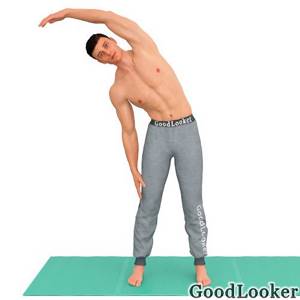
Raising hands
Without changing the position of your legs, straighten your body, maintaining its natural curve in your back. After this, spread your arms out to the sides as wide as possible, trying to feel a moderate stretch in the pectoral muscles. Be sure to lower your shoulders to avoid unnecessary stress on your trapezius and neck.
This movement is aimed at relaxing the target muscle group of the thoracic region, as well as the anterior deltas. The biceps are also stretched.
How long to do: 15-20 seconds.
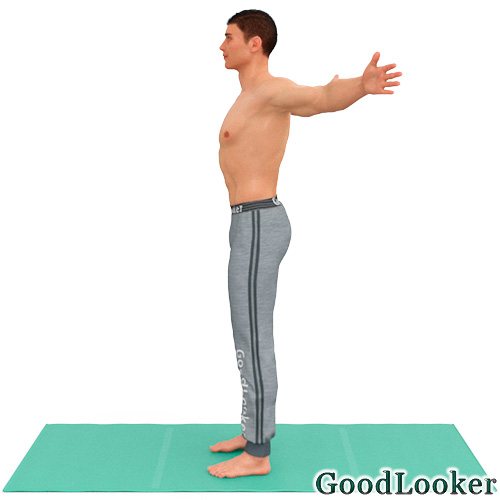
Moving your arm to the side in front of you
Straighten your left arm in front of you, then move it to the right. To maximize the stretch, apply pressure to your left elbow using the pressure of your right palm. Do not overdo it, avoiding outright pain. Also, do not allow the body to rotate, as it must stand straight.
This element is aimed at stretching the rear deltoids, relaxing the upper back muscles, trapezius and triceps.
How long to do: 10-15 seconds on each side.
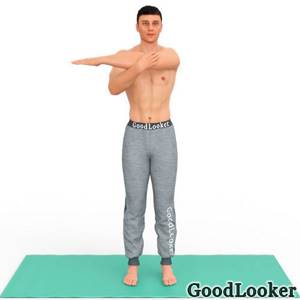
Bending the wrist up and down
Now extend your right arm in front of you and turn your hand so that your palm faces in the same direction. With your left hand, take the fingers of your right, and then begin to gently move them back. After finishing the repetition, turn your working hand with your fingers down, and then pull them back again. The same technique is followed when stretching the left hand.
This will not only help relax the wrist joint itself, but also relieve tension in the forearms and biceps.
How long to do: 10-15 seconds on each side.
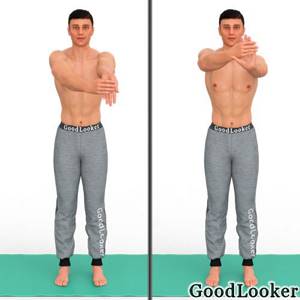
Retraction of the bent arm behind the back
Raise your left arm and bend it at the elbow joint so that your palm is between your shoulder blades. Place your right palm on your left elbow, and then begin to gently pull it up, thereby stretching the triceps of the working limb. After completing the exercise, switch sides and follow the same technique.
In addition to the triceps, the element helps to stretch the rear deltoids and the latissimus dorsi muscle.
How long to do: 10-15 seconds on each side.

Shin flexion
Place your legs closer to each other, then bend your left leg so that its heel reaches the bottom of your buttock. Additional force is applied through the influence of the left hand. Grab the toes of your working leg and begin to pull it closer to the back of the thigh. After spending the specified amount of time repeating, switch sides.
The post-workout stretching element focuses on stretching the quadriceps as well as relaxing the ankle joint.
How long to do: 10-15 seconds on each side.
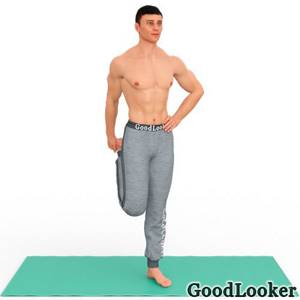
Knee pull-up
Now, without changing the position of your legs, lift your right leg so that your knee is pressed to your lower chest. To increase the tension, grab your shin with both hands, pressing the limb as close to your body as possible. After finishing the repetition, do the same work on the other leg.
The element is aimed at stretching the gluteal muscles, as well as the hamstrings. And with its help you can greatly develop coordination and balance.
How long to do: 10-15 seconds on each side.
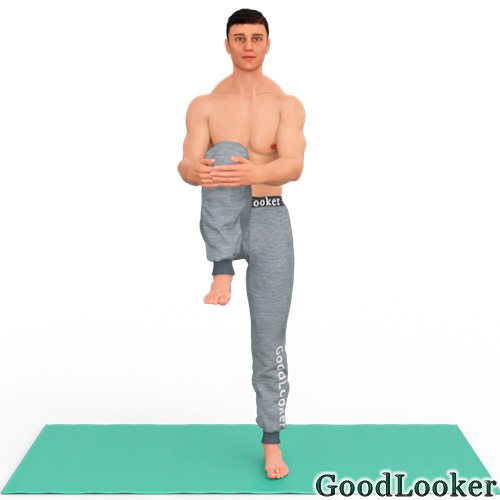
Tilt to straight leg
Take a step forward, bend your body and place both hands on the knee of your front leg. Lock the position. After this, take a similar step, putting your other leg forward. Again, we lean on her knee with both hands.
This will allow you to further stretch your hamstrings, calves, and engage your glutes and lower back.
How long to do: 10-15 seconds on each side.

Back arch
Place your legs at the level of your collarbones, then bend your back like a cat. Cross your arms and grab your inner thighs with your palms to increase the tension. Hold the position for a few seconds, then relax and straighten up.
This is a very useful exercise for back health, removing the feeling of tightness, discomfort and pain. It also helps stretch the rear deltoids, triceps and forearms.
How long to do: 15-20 seconds.

Deep Lunge
The element is great both for warming up before training and as a stretching exercise. Take a long step forward, then lower your weight onto your front leg. The angle of the bend of her knee joint should be at least 90 degrees. Keep your back straight with an even posture. For a new approach, do the same on the other leg.
Thanks to the exercise, the muscles of the lower extremities are stretched, and their static strength also increases.
How long to do: 10-15 seconds on each side.
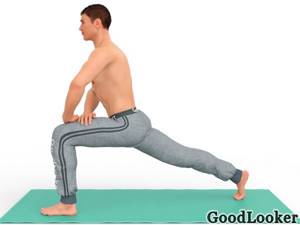
Side lunge
This exercise is somewhat similar to the previous one, but we will lunge not forward, but to the side. To begin, shift your body weight to your right leg. It should be bent at a right angle. The left one, in turn, is extended as much as possible. After finishing the repetition, do the same work, resting your weight on your left leg. Watch your back position. It should be smooth, without bends or turns.
The element is aimed at stretching the adductor muscles and biceps of the thigh, as well as the calf muscles and buttocks.
How long to do: 10-15 seconds on each side.

Tilt to the floor
Final post-workout stretching exercise. With your feet close to each other, lean your body forward, trying to touch your palms to the floor. The legs should not bend at the knee joint. Try to press your stomach closer to the surface of your thighs. The exercise allows you to perfectly stretch the hamstrings, buttocks, lumbar region, latissimus muscle, as well as the muscles of the upper limbs in the complex.
How long to do: 15-20 seconds.
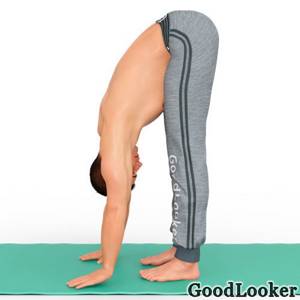
See also our selection for a healthy back:
- Gymnastics exercises for straight posture
- Gymnastics exercises for the back while standing
- Gymnastics exercises for lower back pain
- Exercises to strengthen the lumbar muscles
- Pilates exercises to strengthen your back
- Upper back and neck stretching exercises
The best exercises to stretch your back
Step - tilt. This element of the program allows you to improve the flexibility of the muscles of the back, hamstrings and buttocks. Stand up straight and take a step forward. Then, without rounding your back, bend over and try to touch your front foot.
It's okay if you can't do it right away. Try to get lower and lower towards your goal with each step. Returning to the starting position, repeat the exercise on the other leg. Only 12 - 14 steps.
Lazy stretches. You can do it right at your desk or in front of the TV. Sit on a chair, straighten up and tighten your abdominal muscles. Without rounding your back, lift your right knee toward your chest
Place your hands on your shin and gently pull it towards you
When you feel a sufficient stretch in your lower back, hold for 30 seconds and then repeat the same on your left leg.
Bends while sitting. The deep muscles located along the spine are well stretched. Sit on the floor, legs bent at the knees and widely spaced, back straight.
Take a deep, slow breath and relax your muscles, and as you exhale, bend forward as much as possible with your arms outstretched, trying to lie with your chest on the floor until you feel a sufficient stretch across your entire back. Hold the stretch for 30 seconds while continuing to breathe deeply. Repeat at least 4 – 6 times.
Gymnastic stretches. This static element of the program provides a deep stretch to the upper back muscles.
To perform it, stand close to the doorway and clasp it with your right hand at waist level. Inhale deeply and as you exhale, bending your lower back, tilt your torso down. At the same time, move your buttocks back as far as possible until you feel an optimal stretch on the right side of your back. Hold the position for 30 seconds and then repeat with your left hand.
"Good morning". This movement stretches the lower back and hamstrings.
Stand up straight with your hands clasped behind your head (or on your chest). As you bend at the waist, bend your upper body as low as you can. Always keep your back straight at this moment. Then return to the starting position and repeat another 10 - 12 times.
Warm up before a HIIT workout
Warming up before a HIIT workout is a must-do exercise that prepares your body for the upcoming stress. Muscles and joints are put on alert. As a result, the risk of injury is significantly reduced, so preliminary preparation should absolutely not be neglected. In total, we offer 10 exercises, each of which focuses on a specific muscle group. Also, a set of movements helps accelerate blood circulation, alerting the cardiovascular system.
Other warm-up complexes:
- Ready-made warm-up and cool-down for arm and shoulder training
- Ready-made warm-up and cool-down for back and biceps training
- Ready-made warm-up and cool-down for chest and triceps training
Arm raises with shin wraps
To begin, place your legs in line with your collarbones and spread your arms into a T-shape position. After this, begin to bring the upper limbs together in front of you (with crossing at the peak point), and then spread them. At the same time, take steps with your shin overlapping, trying to press it more tightly to your thigh.
The starting element during the warm-up before Tabata simultaneously includes the upper and lower torso, due to which it accelerates metabolic processes, blood circulation, and also warms up the shoulders and back of the thigh.
How much to do: 8-10 arm raises.

Arm rotations with shin wraps
You can start performing a new movement without interruption from the previous one (do this according to your personal feelings). We continue to take steps with the shin overlapping, but the movement of the arms is already rotational. Try to describe as large a circle as possible with your upper limbs, without rushing anywhere. Your task is to perfectly warm up the shoulder joint, which is one of the most vulnerable and prone to injury.
In addition to a high-quality warm-up of the shoulders and arms, the exercise also loads the hips and perfectly warms up the entire body.
How much to do: 8-10 arm rotations.
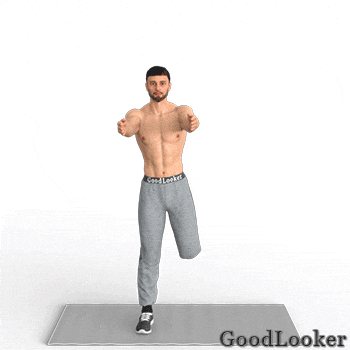
Reduction of arms with overlap of shins
Now our task is to bend our arms at the elbow joint at a right angle and point our fists upward. The next movement is comparable to the “butterfly” exercise on the simulator. Bring your arms together in front of you, then move them back, maintaining an average tempo. At the same time, we perform steps with the shin overlapping in the same mode.
This is a great way to activate your pectoral muscles, anterior deltoids, and shoulder joints. By kicking our legs, we continue to increase our heart rate, accelerate blood circulation, and stretch our leg muscles.
How much to do: 8-10 arm raises.
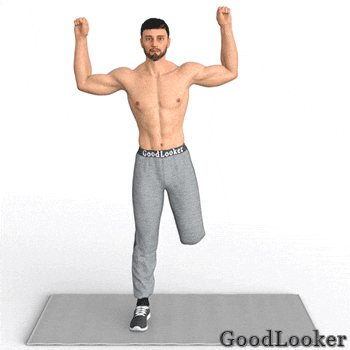
Hip rotation
The hip joint should be given special attention. With your hands on your waist, straighten your back and look straight ahead. Shoulders slumped. After this, begin to perform hip rotation. Raise your knee until your thigh is parallel to the floor. Next, move it to the side, feeling a moderate stretch in the adductor muscle and groin area. After this, we return the leg to its place. A new repetition is accompanied by a change of sides.
In addition to warming up the hip joint, the exercise warms up the quadriceps, buttocks, sides of the legs, and lower abs.
How much to do: 4-5 rotations with each leg.
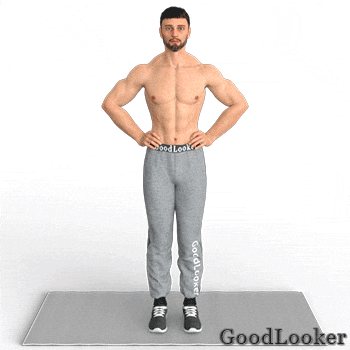
Squats + side bends
Warming up before Tabata is not complete without squats. Let's perform a complex element to warm up the upper body at the same time. Place your lower limbs at shoulder level, then perform a standard squat. The squat is done to a right angle in the bend of the knee joints. After you stand up, fix your right hand on your belt and raise your left hand up. Next, we tilt the body to the right side. After a new squat, the sides change - we lean to the left.
In addition to warming up the lower body and activating the leg muscles, the element helps stretch the muscles of the back, posterior deltoids, oblique and rectus abdominis muscles.
How much to do: 4-5 bends on each side.
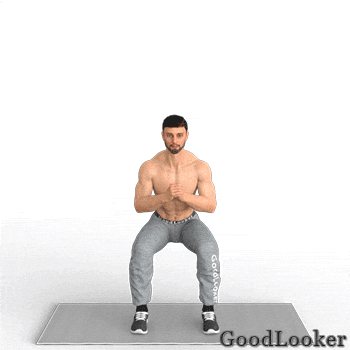
"Mill"
Before starting the exercise, assume the “star” position. The legs are spread wide apart and the arms are spread in different directions. After this, we make a deep tilt with the body forward diagonally, trying to touch the right foot with the left palm. We carefully stand up and straighten up. After the next tilt, the touch is made with the right palm of the left foot.
This is one of the best movements for warming up your back, hamstrings and hamstrings, while also relieving lower back pain and strengthening your side core.
How much to do: 4-5 bends on each side.
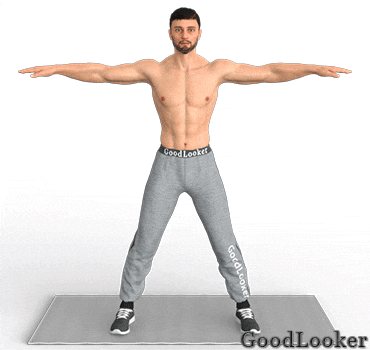
Lateral rolls from foot to foot
We continue to warm up the muscles and joints of the lower body before training. Place your feet wider than shoulder-width apart and lean your body forward slightly. Keep your hands locked in front of you. After this, shift your body weight to one leg, doing a side lunge to the side. In the peak phase, the bend angle of the knee joint should be 90 degrees, do not bring the knee forward of the toe. After this, transfer your body weight to the opposite side, doing a roll.
Leg-to-leg lateral lunges are a great way to warm up the muscles in your hips and buttocks, as well as stretch your knee joints.
How much to do: 4-5 lunges on each leg.
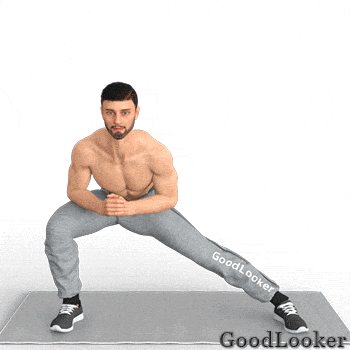
Pulling the knee to the chest with rotation of the feet
The work is done while standing. Lift your right knee and press it towards your chest with both hands. While in this position, rotate your toes, then lower your leg back down. Using a similar technique, we work with the left leg, pressing the knee to the chest and further turning the toe. Alternate between rotating your foot clockwise and counterclockwise.
This exercise allows you to perfectly stretch the back of the thigh, buttocks, and also warm up the ankle, which is subjected to very heavy loads during HIIT training.
How much to do: 4-5 knee pull-ups on each leg.
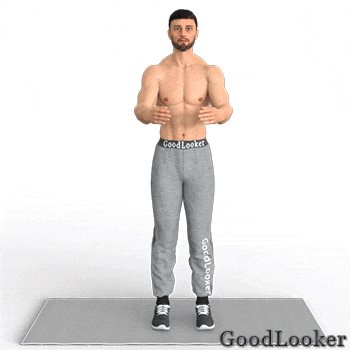
Jumping with wrist rotations
This is an excellent compound exercise to warm up before a cardio workout. The movement technique is extremely simple. You need to jump from foot to foot, moving your free limb to the side. At the same time, we rotate our hands, clenched into a fist, with our arms outstretched in front of us.
The exercise itself is an element of warm-up cardio, and additional rotations help to properly stretch the wrist joint, which is especially important before planks, push-ups and weight exercises. If jumping is contraindicated for you, simply move your leg to the side one at a time and rotate your hands without jumping.
How much to do: 6-8 wrist rotations in one direction and 6-8 wrist rotations in the opposite direction.
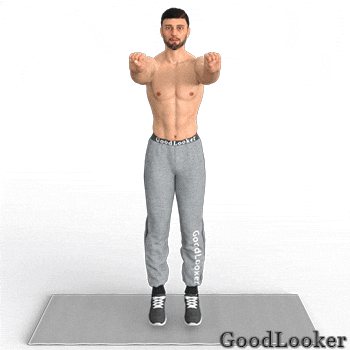
Raising arms through the sides while running in place
Another comprehensive warm-up element for cardio training, simultaneously involving the work of the upper and lower body. Perform a regular jog in place at an easy pace. At the same time as you run, begin to raise your arms above your head to your sides. Take your time, you should not be tired after the warm-up, but on the contrary, you should be full of energy for further training.
A universal exercise that is perfect for warming up before any loads of varying intensity. If running is contraindicated for you, just walk in place with your knees high.
How much to do: 10-12 arm raises.

Stretching dynamic stretching
22.02.2016
Neglecting to stretch after workouts? And in vain: it prevents injuries and extends the “lifespan” of our joints and ligaments.
There are four types of stretching - static, proprioceptive, ballistic and dynamic. Our fitness complex is based on dynamic stretching. It involves smooth movements that end with a short fixation of the body at the end point of the amplitude. Thanks to this, dynamic stretching does not take as much time as static stretching, with long-term fixation of the final pose. And the absence of sudden movements (as in ballistic stretching) makes it safe for people with problem joints. Moreover, dynamic stretching improves athletic performance and reduces the risk of injury during exercise. In addition, it helps relieve back tension after a working day. Perform our complex before a run, as a cool-down after a workout, or at home after work - and you will become more flexible in just 3 weeks!
Training plan
Exercise twice a week, doing all the exercises in order. Repeat the complex, performing exercises 2-6 on the other side.
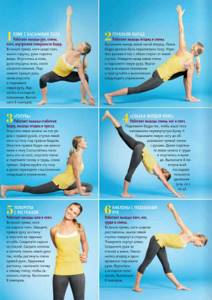
Plie with floor touches
The muscles of the arms, back, shoulders, and inner thighs work.
Stand straight, feet wider than shoulder width, toes pointed out, arms raised up. Lower yourself into a plie, arms down, elbows touching knees. Raise your right arm, then lower and raise your left arm. Return to the starting position. Perform 8 repetitions.
Deep Lunge
The muscles of the buttocks and back work.
Lunge forward with your left leg. The left thigh should be parallel to the floor. Place your hands on the floor on either side of your left foot. Pull your left shoulder back and raise your left arm. Return to the starting position and proceed to the next exercise.
Pigeon
The hip flexors, buttocks and abdominal muscles work.
Place your left knee on the floor next to your right hand, with your left foot on the floor under your right thigh. Lower your right thigh as low as possible to the floor (try to lay it on the floor), lower your shoulders and tuck your head and chest, keeping your back straight. Fix this pose and then proceed to the next exercise.
Downward facing dog
The muscles of the back, legs and shoulders work.
Raise your hips so that your body resembles an inverted V. Raise your left leg until it forms a straight line with your arms. Next, pull your left knee toward your chest and lower into a lunge. Perform 8 repetitions of the entire movement sequence (exercises 2 to 4).
Stretch turns
The muscles of the neck and shoulders work.
Stand straight with your feet shoulder-width apart. Place your right hand behind your back and lower it with your palm facing away from you. Place your palms behind your back. Squeeze your shoulder blades and bend your left elbow to stretch your right shoulder. While holding the stretch, tilt your head toward your left shoulder to complete the repetition. Perform 8 repetitions.
Bend overs with arm raises
The muscles of the shoulders, legs, chest and back work.
Stand straight, legs wide apart, toe of your left foot turned to the side. Turn your body to the left. Join your hands behind your back in a lock. Lean forward and raise your arms at the same time. Return to the starting position. Perform 8 repetitions.
The article was taken from the site bodymaster.ru.
Stretching - women
What type of stretching to choose
Static stretching is best done after a workout. Thanks to this, the muscles do not become clogged and the pain is much less the next day.
It is better to do dynamic movements after warming up so that the muscles become toned. This way, the likelihood of pulling a muscle or getting injured while playing sports is significantly reduced.
It is worth mentioning that dynamic stretching is divided into active and ballistic. Active is based on smooth movements with fixation at the extreme point. Ballistic - on sudden movements with jerks.
Stretching or stretching and flexibility exercises for beginners
Of course, the process of stretching does not actively promote weight loss, but it actually helps prepare your body for those strenuous forms of exercise (aerobic, strength or plyometric) that will allow you to quickly lose excess weight, as well as improve your range of motion and protect your joints and muscles from possible injuries.
What are the benefits of stretching for beginners?
Improves blood flow. Performing a set of stretching exercises encourages improved blood supply to all tissues of your body, including the brain. Morning exercises will help you get an extraordinary boost of energy, a high level of concentration, and also prevent fatigue and lethargy after a night's sleep. A good stretching program will involve all your vital organs, including your heart, in active work, relieving it of excess internal tension throughout the day.
Increases flexibility. Another benefit of stretching is that it significantly improves the flexibility of your entire body by increasing the range of motion of your major joints (hip, shoulder, ankle, etc.). This moment will allow you to move more freely and efficiently.
Supports a sense of balance. Lack of flexibility in one or more muscle groups can lead to muscle imbalances and, as a result, poor posture. Tight muscles negatively impact the joints, slowly creating a shift from their normal alignment. Connective tissue gradually shortens to adapt to these conditions. All this leads to a situation where the body begins to lose the ability to function at full capacity, which causes frequent injuries.
Relieves stress. Static stretching can be relaxing, both physically and mentally. Using deep and slow breathing during exercise effectively reduces the feeling of stress, one of the side effects of which is an increase in muscle tension.
Relaxes muscles. Morning stretching exercises will help make your muscles more elastic, which leads to their overall relaxation. And this is a huge plus! After all, tension in the muscles can lead to the development of discomfort, spasms and pain. And stretching allows muscle fibers to warm up and relax, which significantly reduces the risk of injury during strength training.
Prepares you for training. If you have another visit to the gym planned for today, start preparing your body from the moment you wake up. Stretching in the morning will prime your body for physical activity and help prevent muscle damage. And they, according to researchers, can greatly improve the overall level of your athletic performance.
Helps during the rehabilitation period. If you have suffered an unpleasant injury during strength training, then regular stretching sessions will help speed up your healing.
But, do not forget that this process must be gradual! That's why it's so important not to overdo it, otherwise you can cause even more harm.
Increases bone mineralization. In addition to making you physically stronger, proper stretching has additional benefits for your skeletal system. Due to the increased load on the bones, it significantly increases their mineral density, which helps prevent the development of osteoporosis and various fractures.
Promotes weight loss! And finally, stretching accelerates muscle growth and improves body composition by reducing the percentage of fat tissue
This is very important, since the opposite process occurs in the body over time, and muscle cells, as we know, due to their metabolic activity, require more energy throughout the day.
How to stretch correctly
Before you rush headlong into the pool, remember the rules for stretching that will keep your muscles and joints healthy:
- Warm up your body before starting stretching exercises. “Cold” joints and muscles stretch poorly, and therefore it is very easy to get injured in the form of a sprain or tear. To “warm up”, you can choose any of the aerobic activities: running, jumping rope, exercise bike or orbitrek. If you are doing anaerobic (strength) exercises, stretch at the end of the session, as it helps to relax the muscles, and you will get worse results when lifting weights if you stretch before starting the exercises.
- Perform stretching exercises smoothly, without sudden movements and with a small amplitude (ideal - static stretching).
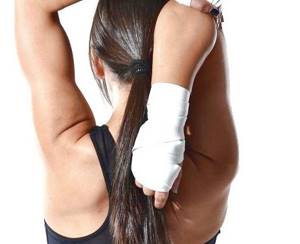
- Do not tense your muscles while stretching. Relaxed, they will stretch much easier.
- Don't slouch while doing stretching exercises. A slouched back, bent knees, and tense muscles make stretching ineffective.
- Breathe calmly and don't hold your breath. In the starting position, inhale through your nose, and at the moment of stretching, exhale through your mouth. If you are doing static exercises, breathe deeply on each count.
- Perform each stretch for 30-60 seconds. The stretching time depends on the flexibility of your joints and muscles, so if you find it difficult to hold your body for 1 minute, start with the maximum time possible (10-20 seconds) and gradually increase it, bringing it to the required 60 seconds.
- Do stretching exercises regularly. Starting three times a week and depending on how you feel, increase the duration and frequency of your workouts. Ideally, you should do stretching for 30-50 minutes daily (except for professional dancers, who spend 1.5-2 hours stretching per workout).
- Avoid severe pain. Stretching is a traumatic process and therefore it is better to listen to the body’s signals. If during stretching your muscles hurt a little, but you feel that it has an effect, they stretch and do not cause severe discomfort - everything is normal. If, during stretching, something crunches, rings in your ears, or begins to feel nauseous due to severe pain, immediately finish the exercise and from now on be guided by your own sensations.
- Stretch your body symmetrically. After spending 5 minutes on the right quadriceps, leave the same amount of time on the left front thigh. Only if you stretch symmetrically can you achieve benefits for your body.
How to Improve Abdominal Stretching
"Awakening". This exercise helps to stretch not only the anterior and oblique abdominal muscles, but also the deep muscles that run along the spine.
Stand straight with your feet shoulder-width apart. Interlace your fingers and extend your arms above your head, palms facing the ceiling. Inhale and squeeze your glutes and abdominals while stretching your arms upward. Exhale and lean to the right, keeping your hips engaged. Hold for 20 – 30 seconds and return to the starting position. Reach towards the ceiling again and tilt in the other direction.
Bow pose. An excellent exercise for stretching the abdominal and chest muscles, it gets its name because your body will resemble the shape of a bow when you do it.
Lie on your stomach and bend your knees. Then, bending your spine well, grab your ankles with your hands. To increase tension in muscle fibers, lift your legs as high as possible towards the ceiling and draw your heels closer to your buttocks. With the ideal technique for performing the pose, you will touch the surface of the floor only in the abdominal area.
Soft bridge. To complete the element you will need a fitball. Sit on the ball with your knees bent and your feet slightly turned outward for a greater sense of balance. Leaning back, begin to move your feet forward until the ball, rolling under you, stops in the middle of your back.
Raise your arms up, arch your torso and try to reach the floor with your palms. At this moment, you will feel the chest and abdominal muscles (obliques, transverse and rectus muscles) stretching.
Cobra twist. It is especially effective for the internal and external oblique muscles of your waist and is similar to cobra pose. To perform, lie on your stomach with your legs straight. Press your palms into the floor, as if you were doing push-ups, and then, pushing with your hands, lift your upper body and arch your spine well.
Bend your right arm and rotate your torso to the left. You should feel how well the muscles on the left side of your abdomen stretch. Pause for a while at the point of maximum resistance and repeat the movement in the other direction.
Rotations on a chair. The exercise perfectly stretches the muscles of the abdomen and lower back, which are involved in turning the body to the right and left.
Sit on the front edge of a chair with your feet flat on the floor. Turn your torso as far as possible to the left and grab the back of the chair with both hands. Additionally, tighten your core muscles, hold for 5 – 10 seconds and return to the starting position. With the next turn, try to take an even greater range of motion. Only 3 – 5 times, then similarly in the other direction. Published by econet.ru.
PS And remember, just by changing your consciousness, we are changing the world together! econet




